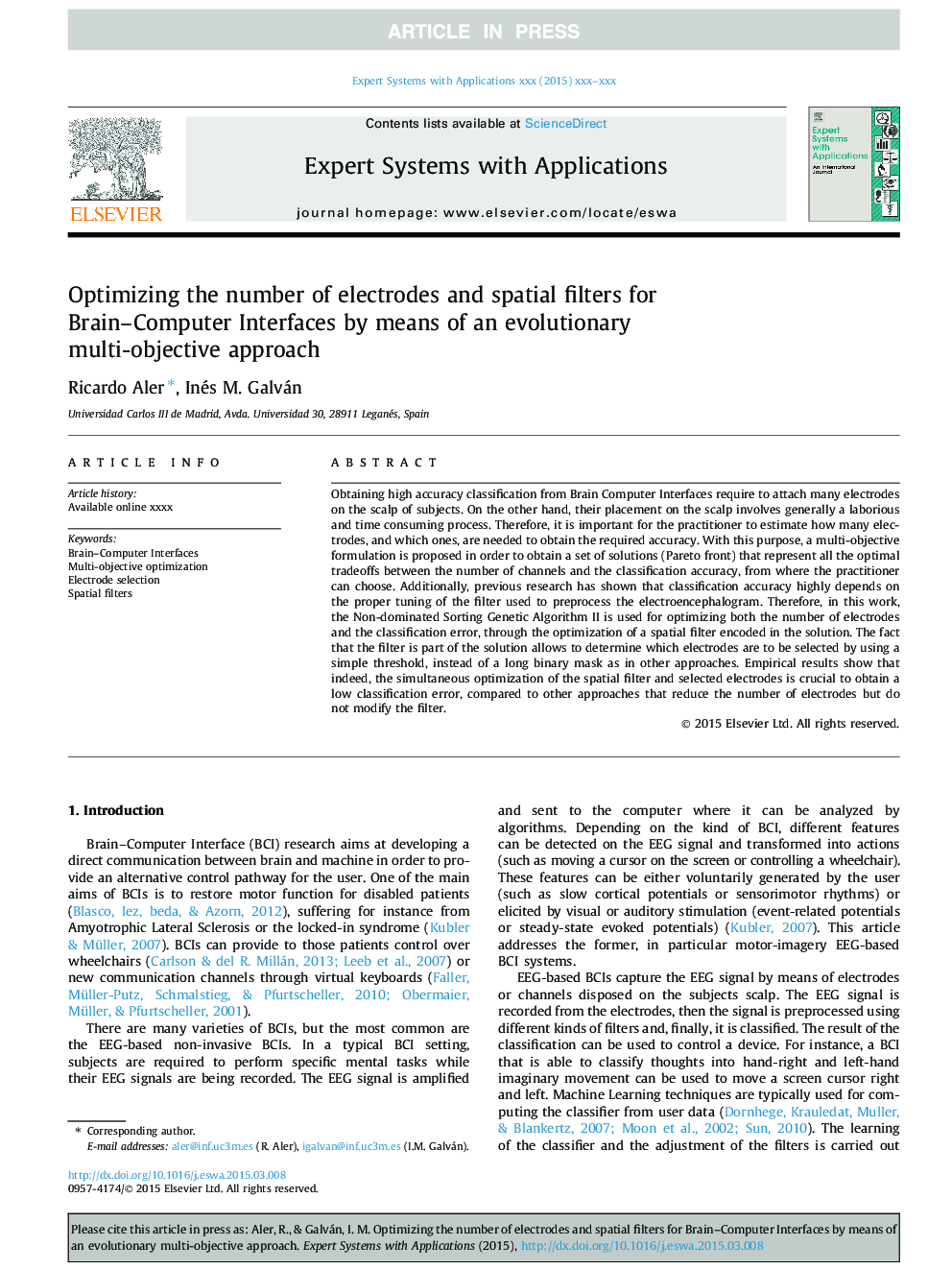| کد مقاله | کد نشریه | سال انتشار | مقاله انگلیسی | نسخه تمام متن |
|---|---|---|---|---|
| 385176 | 660861 | 2015 | 9 صفحه PDF | دانلود رایگان |
عنوان انگلیسی مقاله ISI
Optimizing the number of electrodes and spatial filters for Brain-Computer Interfaces by means of an evolutionary multi-objective approach
ترجمه فارسی عنوان
بهینه سازی تعداد الکترودها و فیلترهای فضایی برای اینترفیس مغز-کامپیوتر با استفاده از یک رویکرد چند هدفه تکاملی
دانلود مقاله + سفارش ترجمه
دانلود مقاله ISI انگلیسی
رایگان برای ایرانیان
کلمات کلیدی
ترجمه چکیده
به دست آوردن طبقه بندی دقیق بالا از اینترفیس کامپیوتر مغز نیاز به اتصال بسیاری از الکترودهای روی پوست افراد. از سوی دیگر، قرار دادن آنها روی پوست سر به طور معمول یک فرایند سخت و وقت گیر است. بنابراین، برای تمرینکننده مهم است که تعداد الکترودها و آنهایی که لازم است برای به دست آوردن دقت مورد نیاز، تخمین بزنند. با این هدف، یک فرمول چند منظوره برای به دست آوردن یک مجموعه ای از راه حل ها (جبهه پارتو) ارائه می شود که نشان دهنده تمام توافق های مطلوب بین تعداد کانال ها و دقت طبقه بندی است که از آن می توان عملگر را انتخاب کرد. علاوه بر این، تحقیقات قبلی نشان داده است که دقت طبقه بندی به شدت به تنظیم مناسب فیلتر مورد استفاده برای پیش پردازش الکتروانسفالوگرام بستگی دارد. بنابراین، در این کار، الگوریتم ژنتیک مرتب غالب غالب غالب نمی شود، برای بهینه سازی هر دو تعداد الکترودها و خطای طبقه بندی از طریق بهینه سازی یک فیلتر فضایی کدگذاری شده در محلول استفاده می شود. واقعیت این است که فیلتر بخشی از راه حل است که اجازه می دهد تا به جای یک ماسک دوتایی طولانی مانند سایر شیوه ها، با استفاده از یک آستانه ساده انتخاب شود که چه الکترودهای باید انتخاب شوند. نتایج تجربی نشان می دهد که در واقع، بهینه سازی همزمان فیلتر فضایی و الکترودهای انتخابی برای به دست آوردن یک خطای طبقه بندی پایین، در مقایسه با روش های دیگر که تعداد الکترودها را کاهش می دهد، اما فیلتر را اصلاح نمی کند، حیاتی است.
موضوعات مرتبط
مهندسی و علوم پایه
مهندسی کامپیوتر
هوش مصنوعی
چکیده انگلیسی
Obtaining high accuracy classification from Brain Computer Interfaces require to attach many electrodes on the scalp of subjects. On the other hand, their placement on the scalp involves generally a laborious and time consuming process. Therefore, it is important for the practitioner to estimate how many electrodes, and which ones, are needed to obtain the required accuracy. With this purpose, a multi-objective formulation is proposed in order to obtain a set of solutions (Pareto front) that represent all the optimal tradeoffs between the number of channels and the classification accuracy, from where the practitioner can choose. Additionally, previous research has shown that classification accuracy highly depends on the proper tuning of the filter used to preprocess the electroencephalogram. Therefore, in this work, the Non-dominated Sorting Genetic Algorithm II is used for optimizing both the number of electrodes and the classification error, through the optimization of a spatial filter encoded in the solution. The fact that the filter is part of the solution allows to determine which electrodes are to be selected by using a simple threshold, instead of a long binary mask as in other approaches. Empirical results show that indeed, the simultaneous optimization of the spatial filter and selected electrodes is crucial to obtain a low classification error, compared to other approaches that reduce the number of electrodes but do not modify the filter.
ناشر
Database: Elsevier - ScienceDirect (ساینس دایرکت)
Journal: Expert Systems with Applications - Volume 42, Issues 15â16, September 2015, Pages 6215-6223
Journal: Expert Systems with Applications - Volume 42, Issues 15â16, September 2015, Pages 6215-6223
نویسندگان
Ricardo Aler, Inés M. Galván,
